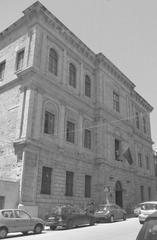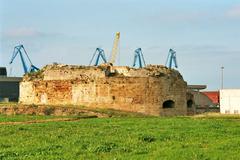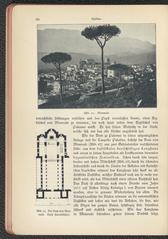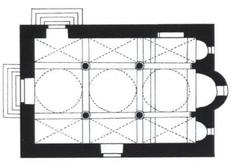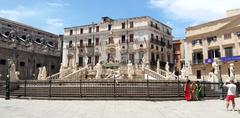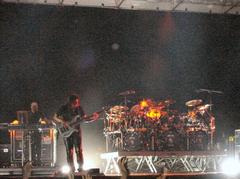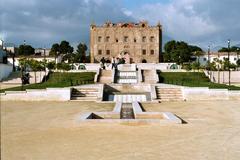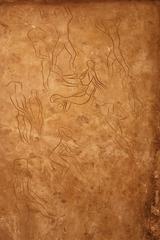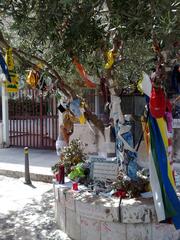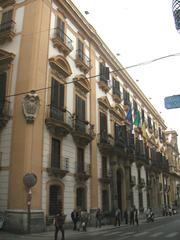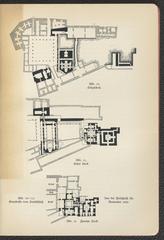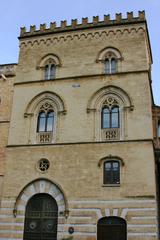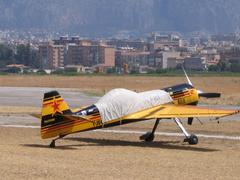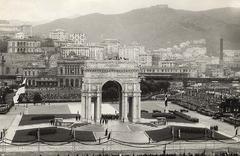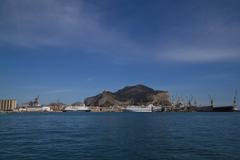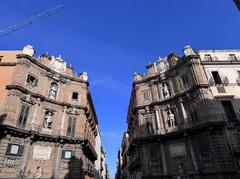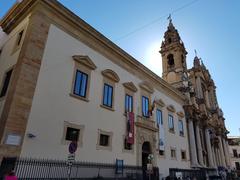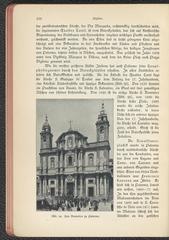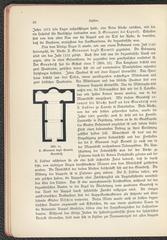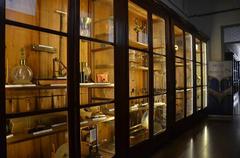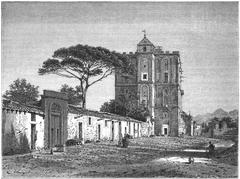Visiting Castellaccio Di Monreale: History, Tickets, and Travel Tips
Date: 17/08/2024
Introduction
Castellaccio di Monreale, perched atop Monte Caputo near Monreale in the Palermo Province of Sicily, is a historical gem that offers visitors a unique glimpse into Sicily’s diverse cultural heritage. Known also as the Castle of San Benedetto, this fortress has a rich history that spans several centuries and various cultural influences. The origins of Castellaccio can be traced back to the Arab rule over Sicily, where its strategic location made it a vital site for defense and control (Audiala). During the Norman period, the fortress was extensively reconstructed by William II, who transformed it into a fortified religious complex entrusted to the Benedictine monks of Monreale (Italy Heritage). This blend of military and monastic functions is evident in its architecture, characterized by thick walls, numerous towers, and arrow slits, making it a prime example of Arab-Norman architecture (Istituto Italiano Castelli). Despite its prominence, Castellaccio faced significant turmoil, particularly in 1370 when it was attacked by Giovanni Chiaramonte’s forces, leading to its decline and eventual abandonment in the late 16th century (Istituto Italiano Castelli). However, restoration efforts initiated by the Sicilian Alpine Club in 1897 have preserved this historical landmark, ensuring its accessibility to future generations (Wikipedia). Today, Castellaccio di Monreale stands as a testament to the island’s rich and diverse historical tapestry, offering breathtaking views from Monte Caputo and serving as a significant cultural and historical landmark (Audiala).
Table of Contents
- [Visiting Castellaccio Di Monreale: History, Tickets, and Tips](#visiting-castellaccio-di-monreale-history-tickets-and-tipsvisiting-castellaccio-di-monreale-history-tickets-and-tips)
- [Introduction](#introductionintroduction)
- [Historical Significance of Castellaccio Di Monreale](#historical-significance-of-castellaccio-di-monrealehistorical-significance-of-castellaccio-di-monreale)
- [Origins and Early History](#origins-and-early-historyorigins-and-early-history)
- [Norman Reconstruction](#norman-reconstructionnorman-reconstruction)
- [Architectural Features](#architectural-featuresarchitectural-features)
- [Military and Monastic Functions](#military-and-monastic-functionsmilitary-and-monastic-functions)
- [Medieval Turmoil and Decline](#medieval-turmoil-and-declinemedieval-turmoil-and-decline)
- [Restoration and Preservation](#restoration-and-preservationrestoration-and-preservation)
- [Cultural and Historical Impact](#cultural-and-historical-impactcultural-and-historical-impact)
- [Modern-Day Significance](#modern-day-significancemodern-day-significance)
- [Visitor Information](#visitor-informationvisitor-information)
- [Visiting Hours and Tickets](#visiting-hours-and-ticketsvisiting-hours-and-tickets)
- [Tours and Special Events](#tours-and-special-eventstours-and-special-events)
- [Accessibility and Travel Tips](#accessibility-and-travel-tipsaccessibility-and-travel-tips)
- [Photographic Spots](#photographic-spotsphotographic-spots)
- [Nearby Attractions](#nearby-attractionsnearby-attractions)
- [Conclusion](#conclusionconclusion)
- [FAQ](#faqfaq)
Historical Significance of Castellaccio Di Monreale
Origins and Early History
Castellaccio di Monreale is believed to have been initially founded by the Arabs during their rule over Sicily. Its strategic location provided a commanding view of the surrounding area, making it an ideal site for defense and control (Audiala).
Norman Reconstruction
The fortress gained significant prominence during the Norman period. William II, also known as William the Good, undertook extensive reconstruction of the site. He added a church and entrusted it to the Benedictine monks of Monreale, transforming Castellaccio into a fortified religious complex (Italy Heritage).
Architectural Features
Castellaccio di Monreale is a prime example of Arab-Norman architecture. The fortress is characterized by its robust construction, with thick walls, numerous towers, and arrow slits, emphasizing its military function. It is a long building (approximately 80 x 30 meters) with irregularly placed rectangular towers on the western front and an entrance tower on the eastern side (Istituto Italiano Castelli).
Military and Monastic Functions
The dual nature of Castellaccio as both a military fortress and a monastic retreat is evident in its design. It served as a lookout and defensive structure while also providing a place of rest and retreat for the Benedictine monks of Monreale Abbey (Wikipedia).
Medieval Turmoil and Decline
In 1370, Castellaccio di Monreale was attacked by the forces of Giovanni Chiaramonte, causing significant damage. Despite its strategic importance, the castle began to decline in the late 16th century, eventually being abandoned. It was later acquired by the Sicilian Alpine Club in 1897, which undertook restoration efforts (Istituto Italiano Castelli).
Restoration and Preservation
Efforts to preserve and restore Castellaccio have been ongoing since the late 19th century. The Sicilian Alpine Club, which acquired the site in 1897, has played a crucial role in maintaining the fortress. Architect Giuseppe Patricolo led the initial restoration efforts in 1898, ensuring that Castellaccio remains a significant cultural and historical landmark (Wikipedia).
Cultural and Historical Impact
Castellaccio di Monreale stands as a testament to the diverse cultural influences that have shaped Sicily over the centuries. The site reflects the confluence of different architectural and cultural traditions, highlighting its importance in the historical narrative of Sicily (Audiala).
Modern-Day Significance
Today, Castellaccio di Monreale is a partially ruined structure that offers visitors an evocative journey through time. The site provides breathtaking views from Monte Caputo and serves as a reminder of Sicily’s rich and diverse historical tapestry. Ongoing preservation efforts ensure that Castellaccio remains accessible to future generations (Audiala).
Visitor Information
Visiting Hours and Tickets
The site is managed by the Sicilian Alpine Club, which organizes tours during the tourist season. While specific ticket prices and visiting hours may vary, it is advisable to check the official website or contact the club directly for the most current information.
Tours and Special Events
Guided tours are available, offering in-depth historical insights and access to specific areas of the site. Special events are occasionally hosted, providing unique opportunities to experience the fortress in different contexts.
Accessibility and Travel Tips
The hike to Castellaccio is demanding and recommended only for the fit or stout-hearted. Visitors should dress modestly, respect local customs, and follow posted rules and regulations to maintain the site’s tranquility. Accessibility may be limited, so it’s best to inquire beforehand for specific needs.
Photographic Spots
The fortress and its surroundings offer numerous photographic opportunities. The panoramic views from Monte Caputo are particularly stunning, making it a favorite spot for photography enthusiasts.
Nearby Attractions
While exploring Castellaccio, visitors can also visit nearby attractions such as the Monreale Cathedral, renowned for its intricate mosaics and Norman architecture. Other notable sites include the Palermo Cathedral, the Norman Palace, and the vibrant Vucciria and Ballarò markets (Audiala).
Conclusion
By understanding the historical significance of Castellaccio di Monreale, visitors can appreciate the site’s role in Sicily’s past and its ongoing cultural importance. The fortress stands as a symbol of the island’s diverse heritage and offers a unique glimpse into the historical narrative of the region.
FAQ
- What are the opening hours of Castellaccio di Monreale? Opening hours vary; it is best to check the official website or contact the Sicilian Alpine Club for current information.
- How much are tickets to Castellaccio di Monreale? Ticket prices may vary and should be confirmed through the official website or the Sicilian Alpine Club.
- Are guided tours available? Yes, guided tours are available and offer detailed historical insights.
- Is Castellaccio di Monreale accessible for all visitors? Due to its location and terrain, accessibility may be limited. It’s advisable to inquire in advance for specific needs.
Call to Action
Stay updated on the latest information and events at Castellaccio di Monreale by downloading the Audiala app, checking out related posts, or following us on social media for more updates.
References
- Audiala. (n.d.). Castellaccio di Monreale. Retrieved from Audiala
- Italy Heritage. (n.d.). Monreale. Retrieved from Italy Heritage
- Istituto Italiano Castelli. (n.d.). Castellaccio di Monreale. Retrieved from Istituto Italiano Castelli
- Wikipedia. (n.d.). Castellaccio di Monreale. Retrieved from Wikipedia
